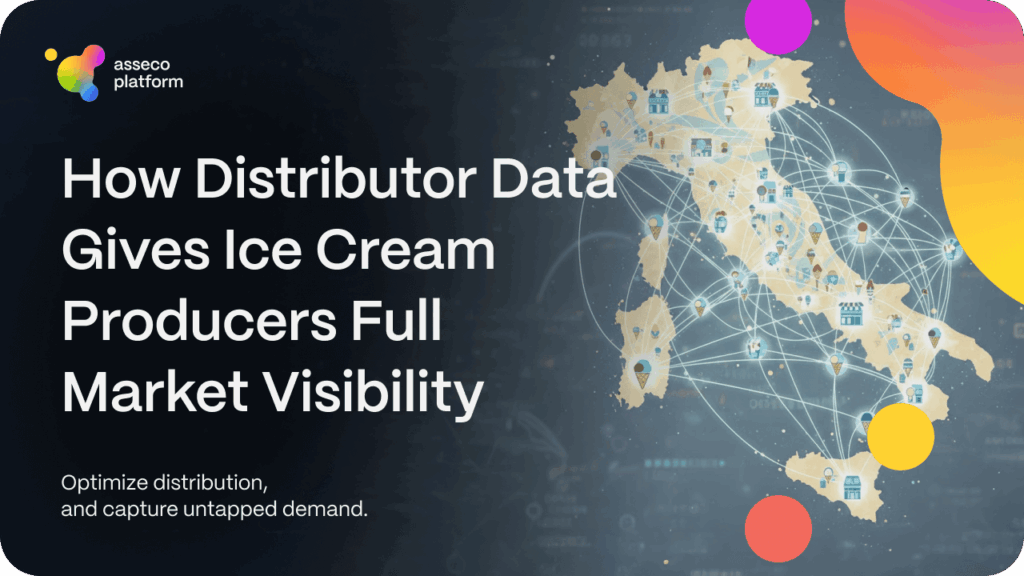How Distributor Data Gives Ice Cream Producers Full Market Visibility
In Italy, ice cream isn’t just a summer indulgence — it’s a year-round pleasure. Cafés, gelaterie, and HoReCa outlets keep demand steady, while supermarkets, kiosks, and beach bars add seasonal peaks. For producers, this creates both an opportunity and a challenge: how to see the entire market, not just the part reached directly by their own salesforce.
Even the largest global ice cream brands face this limitation. Their sales teams visit key accounts and strategic outlets, but thousands of smaller points of sale are reached only through wholesalers. Without access to wholesaler sell-out data, producers operate with blind spots that limit their ability to plan effectively and grow sustainably.
The Visibility Gap
Here’s the situation many ice cream producers encounter:

Direct visibility: Producers see only what their salesforce reports — usually focused on top point of sales.

Wholesaler-driven sales: Separate salesforce — often not shared at all with the producer.

Result: Producers see only a fraction of the market and miss growth opportunities.
This creates three major issues:

Trade marketing inefficiency
Freezer placements and promotions may target the wrong outlets.

Salesforce limitations
Internal teams focus on the current scope of stores to visit, leaving other high-potential outlets untouched.

Weak planning
Without complete data, it’s hard to align strategy with wholesalers or measure performance fairly.
In ice cream, where timing, freshness, and availability are critical, these blind spots are costly.
The Breakthrough: Wholesaler Sell-Out Integration
Leading ice cream producers are solving this challenge by integrating sell-out and stock data directly from wholesaler ERP systems. Instead of relying on sporadic reports, they now access daily insights into:
- Which outlets are buying ice cream,
- Which SKUs and categories are performing best,
- Where regional demand is rising or falling.
This integration turns wholesalers into more than logistics partners. They become a transparent extension of the producer’s salesforce.
From Blind Spots to a Complete Market Picture

Complete Coverage
Instead of seeing only outlets visited directly, producers gain visibility across all retail points served by wholesalers — cafés, kiosks, HoReCa, supermarkets.

Joint Business Planning
Data enables producers and wholesalers to align on shared sales goals, define regional priorities, and collaborate strategically. Trust is built on facts, not assumptions.

Faster Market Response
If a heatwave boosts demand in Sicily, or a ski season drives sales in northern resorts, producers see it immediately and can react with additional supply, promotions, or freezer placements.

RTM Optimization
- Redesign sales territories based on real outlet coverage,
- Assign wholesalers to high-potential regions,
- Optimize salesforce routes to focus on outlets with the highest growth potential,
- Ensure no high-value outlet is left uncovered.
A Real-World Example
One major ice cream producer in Italy integrated wholesaler sell-out data to close its visibility gap. Before the project, the company’s market view was fragmented: it saw sales only in outlets visited by its own reps. Seasonal shops, cafés, and many HoReCa outlets were effectively invisible.
After integration, the producer could:
- Map sales across all outlets and regions,
- Identify under-served areas with high potential,
- Work with wholesalers on joint business plans,
- Restructure its RTM, redirecting resources to the most promising channels.
The result was higher sales, smarter investments, and stronger wholesaler partnerships.

Why This Matters for Ice Cream Producers
Italy is one of the world’s most sophisticated ice cream markets. Consumers expect premium quality and availability not only in summer but also year-round in cafés and restaurants. That means producers cannot afford blind spots.
- Allocate freezers (congelatori) strategically to the outlets that matter most,
- Launch promotions where demand is strongest,
- Plan sales goals based on real market data,
- Rebuild RTM for efficiency and growth.
In other words: visibility isn’t just about knowing what happened — it’s about shaping what comes next.
Tangible Results for the Industry
20–30%
better alignment between production and market demand.
Higher ROI
on promotions, thanks to precise targeting.
Better JBP
improved collaboration with wholesalers through joint planning.
Sustained Growth
by optimizing RTM and market coverage.
Key Takeaway
For ice cream producers in Italy, wholesaler data is no longer optional. It is the foundation for market visibility, joint planning, and RTM optimization. With integrated sell-out insights, producers can treat wholesalers as a true extension of their salesforce, secure year-round availability, and unlock sustainable growth.
Turn your data into results
Do you want to discover how wholesaler data can grow your ice cream business in the Italian market?
Request a personalized demo of Data Sharing and One View Analytics by Asseco Platform and see how stock and sell-out data can be turned into concrete growth decisions.
"*" indicates required fields